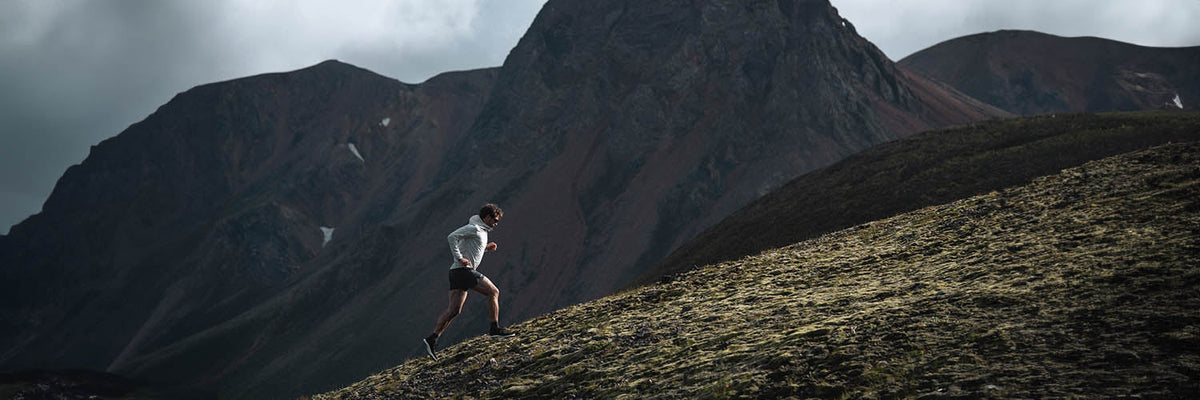
The easiest foot muscle training for runners: barefoot shoes
|
|
Time to read 4 min
|
|
Time to read 4 min
This one is just about the benefits for running athletes. Learn more about general pros and cons of barefoot shoes here .
60% stronger foot muscles. And all without spending a second of time?! When I first started looking into barefoot shoes, the topic grabbed me straight away. I was in the middle of my half marathon preparation and was doing research. And indeed: Far away from the high-tech innovations in the running shoe market - all about carbon plates and EVA compositions - there is a simple truth: less is more. Barefoot shoes strengthen your foot muscles. This is achieved through natural, barefoot-like running. This brings with it a variety of health and sporting advantages. General information, tips against the risk of injury and what I have improved on the barefoot shoe concept for runners - that's what this compact article is about.
Natural foot movement
Barefoot-like running allows for a more natural gait. We focus more on midfoot or forefoot running and use less (strong) heel strike. Barefoot shoes are therefore an easy way to have a natural gait when walking normally, which is stabilized by the toes.
Strengthening the foot muscles :
Wearing barefoot shoes puts more strain on the muscles in the feet than conventional footwear. The main reasons for this are the lack of cushioning and toe spring (the curve at the front of the shoe). A study by the University of Liverpool (Curtis, R., Willems, C., Paoletti, P. et al. Daily activity in minimal footwear increases foot strength. Sci Rep 11, 18648 (2021). https://doi.org/10.1038/s41598-021-98070-0) shows that on average, toe strength increases by up to 57.4%. Even more impressive: Another study (The Effects of Minimalist Shoes on Plantar Intrinsic Foot Muscle Size and Strength: A Systematic Review - Jennifer Xu , Susan A Saliba, Abbis H Jaffri) suggests that barefoot shoes are just as effective as foot strengthening exercises - just without the time investment.
Potential reduction in injuries : Many runners report that switching to barefoot shoes has led to fewer injuries in the long term. For me personally, one thing was striking: since I started experimenting with barefoot shoes, I no longer have any ankle problems (ankle sprains). I used to click around a lot, but now I don't do it at all. One reason for this is that the improved foot muscles and the more natural running technique can strengthen the joints and ligaments. But I'll be clear: this is anecdotal evidence. One could conclude that improved foot muscles mean a lower risk of injury, but there are no studies that have investigated this, let alone proven it!
Particularly important for runners: The transition from conventional (cushioned) shoes to barefoot shoes must be slow. Runners generally have a higher load on their joints; every run can easily put half a tonne of weight on our joints. With minimal shoes, joints are also subjected to more load than with conventional shoes. In the long term, this leads to a strengthening of the joints, but in the short term it is an irritation. I recommend: If you have a training week with a particularly high number of kilometers, plan to start with barefoot shoes a week later. We have developed the Kjavik Sole System to solve this problem: I recommend the Kjavik Comfort Sole especially for the transition. This offers additional cushioning and can reduce the risk of overload, especially at the beginning and during phases with unusually high loads. I usually always wear my shoes in the original "barefoot style" without an insole. However, if I visit another city and do 25,000 steps a day, I like to use the Sole System so that I can run my usual 10km the next day.
The transition to barefoot shoes should be gradual. Start with short walks to get your feet and muscles used to the new freedom of movement. It is normal that unfamiliar muscle groups will be strained at first.
In principle, our motto is: Your body is your best coach: Listen to it!
Here is our complete guide on how to get started with barefoot shoes and what you should pay attention to.
As soon as your feet have got used to the barefoot shoes, you can start jogging with the Kjavik One. This can be done, but it doesn't have to be. It is important to pay attention to your body's signals and reduce the intensity if you feel pain or discomfort. A gradual increase in distance and intensity is crucial for a successful transition without injuries. Of course, it is unlikely that you will be able to achieve your best times with barefoot shoes. Running shoes with functional technology have an unfair advantage here. Nevertheless: stories like the one about the Tarahumara tribe show impressively how well our feet can perform without running shoes. Pay attention to your body. At first, run a maximum of one kilometer per day. Pay particular attention to a light, springy gait with a forefoot strike and slightly shorter steps than usual.
The Kjavik One makes you healthier and stronger. Neither is a bad idea if you have ambitions in running. It is particularly important to get used to it and proceed step by step. This makes barefoot shoes a valuable piece of the puzzle for your new personal best!

